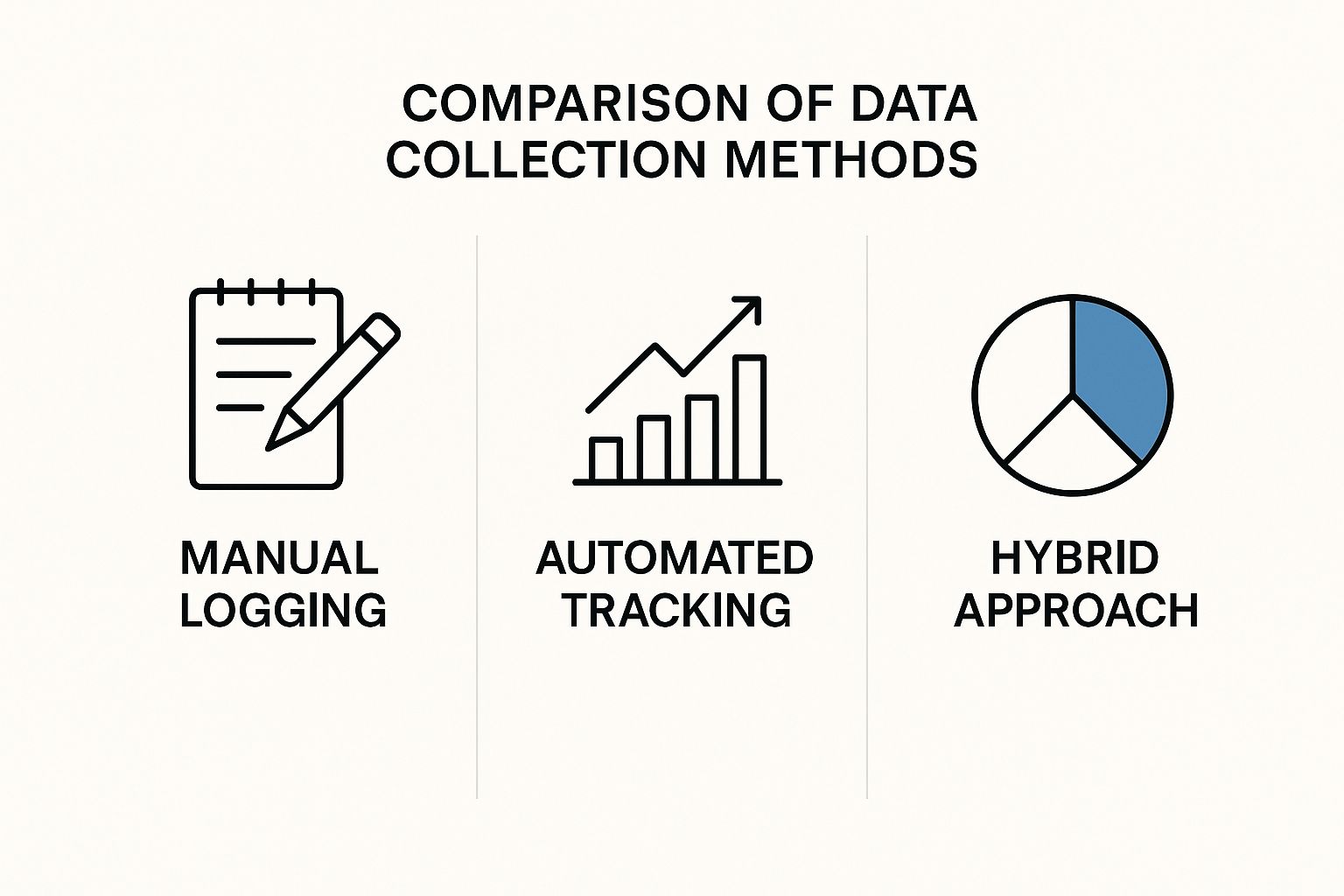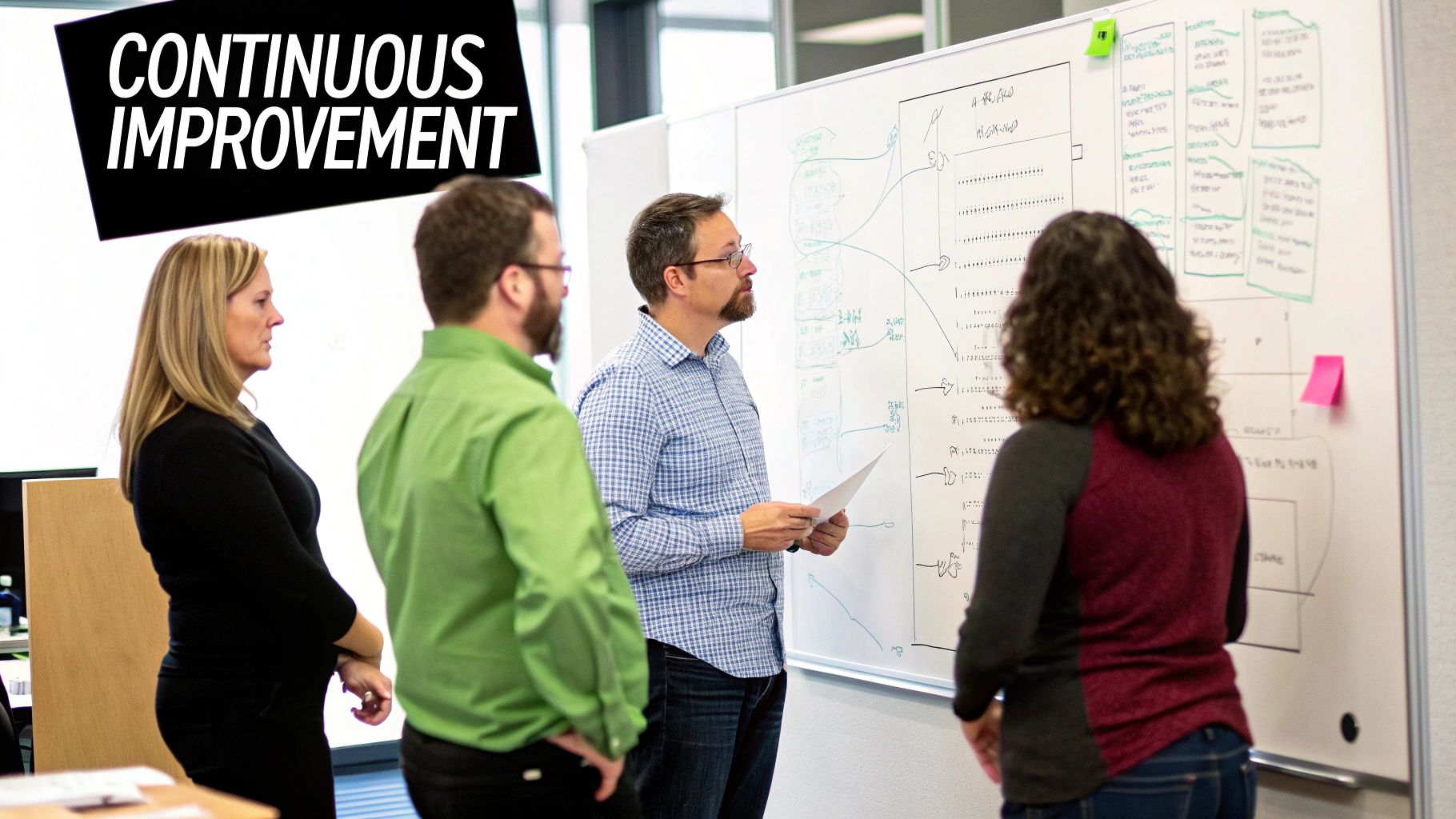- Published on
A Guide to Engineering Productivity Measurement
- Authors

- Name
- Gabriel
- @gabriel__xyz
So, what do we actually mean when we talk about engineering productivity measurement? At its core, it’s about figuring out how effective and efficient a software team is. This goes way beyond just counting lines of code. It’s about understanding how the work gets done, whether it’s pushing the business forward, and what the overall health of the engineering org looks like.
Why Traditional Productivity Metrics Are Broken

For decades, leaders have been stuck trying to figure out engineering productivity measurement. The default has always been to track things that are easy to count but terrible at capturing real value. This old-school approach usually does more harm than good, creating weird incentives that hurt morale and tank product quality.
Think of it like judging a chef by the number of vegetables they chop per hour. Sure, it’s an activity, but it tells you nothing about the flavor, presentation, or creativity of the final dish. In the same way, measuring engineers by raw output is a recipe for disaster.
The Pitfall of Activity Metrics
The biggest mistake is focusing on activity instead of impact. These are often called vanity metrics because they look great on a dashboard but are completely hollow.
Here are a few of the usual suspects:
- Lines of Code (LoC): This is the most famous bad metric. An engineer could write 1,000 lines of bloated, messy code, while another solves the same problem in 50 elegant lines. If you reward more lines, you’re basically encouraging complexity over simplicity.
- Number of Commits: Committing frequently can be a good sign, but it could also just mean a developer is saving their work constantly or making tons of tiny, meaningless changes. It has almost no correlation with actual progress.
- Features Shipped: Shipping a lot of features sounds productive, right? But what if those features are buggy, badly designed, or solve a problem nobody has? This metric pushes quantity over quality and ignores whether customers are actually happy.
These activity-based measurements create a fundamental disconnect. They measure the hammer swings but ignore whether a sturdy, valuable house is being built. The focus shifts from solving problems to simply looking busy.
This isn't a new problem. The earliest attempts at this stuff relied on metrics like Source Lines of Code (SLOC) per person-hour, which completely ignored quality or business outcomes. As far back as 2005, experts were pointing out that real productivity gains come from fixing processes, not just counting outputs. You can see just how long this has been a challenge in this academic overview of systems engineering measurement.
When you lean on these broken metrics, you create a culture where engineers start gaming the system. Instead of building solid, user-focused software, they’ll aim for arbitrary targets, leading to a mountain of technical debt and burnout. This realization is exactly why we need a smarter, more holistic approach to engineering productivity measurement—one that connects engineering effort to real business impact.
Defining What Productivity Means Today
What does it really mean for an engineering team to be productive? It’s not about how fast someone can type or how many tickets they close in a day. That’s just activity. True productivity is all about maximizing impact.
The conversation today has shifted away from simply counting things and moved toward a more balanced view of creating genuine value. This change in perspective is the first step toward any meaningful engineering productivity measurement strategy. Instead of chasing a single, magical number, it’s better to think of productivity as a delicate balance between a few key elements.
The Four Pillars of Modern Productivity
In modern engineering, productivity isn’t a single column; it’s a sturdy structure built on four interconnected pillars. If you neglect any one of them, the whole thing gets wobbly, leading to burnout, creeping technical debt, and products that just don't hit the mark.
A truly productive team strikes a healthy balance between:
- Development Speed: How quickly can an idea get from a whiteboard to a customer’s hands? This covers the entire journey, from the first line of code to the final deployment.
- Code Quality: Is the work solid, easy to maintain, and secure? High-quality code is an investment that prevents future slowdowns and expensive bug hunts.
- System Reliability: Are your systems stable and performing well in the wild? Frequent outages or sluggish performance are the complete opposite of productive.
- Developer Well-being: Is the team healthy, engaged, and not running on fumes? A burnt-out team can't sustain high performance, no matter how great the tools or processes are.
Chasing speed at the expense of quality, for example, is a classic trap. It feels fast at first, but it just creates a mountain of rework down the line. It's a short-term gain for long-term pain.
From Busy Work to Effective Outcomes
Think about an elite motorsports pit crew. Their goal isn't just to be fast; it's to be flawlessly precise. A crew that rushes and fumbles a tire change is actually slower and more dangerous than one that operates with smooth, practiced efficiency. The goal isn't just speed—it’s getting the car back on the track in perfect condition to win the race.
That's the exact mindset shift engineering teams need to make. The focus has to move from just "being busy" to "being effective." Modern engineering leaders get it: productivity is about delivering real business value, not just shipping features for the sake of it.
This is why traditional metrics can be so misleading if the final product doesn't solve a user's problem. The focus has shifted to holistic, outcome-driven measurements. You can learn more about aligning engineering with business value from the experts at Jellyfish.co.
The ultimate goal of engineering productivity measurement is to ensure every line of code, every pull request, and every deployment is directly tied to a tangible business objective or a genuine customer need.
When you look at it this way, measurement stops being a tool for micromanagement and becomes a compass for strategic alignment. It helps teams answer the most important question: "Are we building the right thing, the right way?" By adopting this balanced, outcome-driven view, organizations can build healthier, more effective engineering cultures that consistently deliver work that matters.
Exploring the DORA and SPACE Frameworks
Once you’ve moved past broken metrics, your team needs a reliable map to measure what actually matters for engineering productivity. Two of the best maps out there are the DORA and SPACE frameworks. Each gives you a different—but equally important—lens for looking at your team's effectiveness. Using both is the key to getting the full picture.
Think of DORA as the dashboard in a high-performance race car. It doesn't track how frantically the driver is spinning the steering wheel. Instead, it measures what truly counts: speed, fuel efficiency, and overall engine health. DORA is laser-focused on the software delivery lifecycle.
DORA Measures Delivery Performance
Developed by the DevOps Research and Assessment (DORA) team at Google, this framework pinpoints four key metrics that are powerful predictors of an organization's performance. The bottom line? Elite teams knock these four metrics out of the park.
These are the "big four" of DORA:
- Deployment Frequency: How often do you successfully ship code to production? High-performing teams deploy on-demand, often multiple times a day.
- Lead Time for Changes: How long does it take for committed code to actually make it into production? This is a direct measure of your development process's efficiency from start to finish.
- Mean Time to Recovery (MTTR): When a service incident or a bug hits your users, how fast can you fix it? This reveals how resilient your team is and how quickly it can resolve problems.
- Change Failure Rate: What percentage of your production deployments go wrong and need to be fixed? This is a crucial gauge of both stability and quality.
DORA metrics are so effective because they measure the entire system, not individual engineers. They give you a clean, objective view of your delivery pipeline's speed and stability, helping you find bottlenecks and improve your overall flow. It's no surprise that some of the world's most efficient tech companies build their processes around these ideas. Just look at how Stripe ships over 1,000 pull requests daily by mastering similar efficiencies.
SPACE Provides a Holistic View
If DORA is the car's dashboard, the SPACE framework is the pit crew's health and wellness report. Created by researchers from Microsoft and the University of Victoria, SPACE recognizes that productivity isn't just about output—it's a complex, human-centric concept.
This framework offers a more qualitative look at productivity, breaking it down into five key dimensions.
SPACE reminds us that sustainable productivity is built on a foundation of well-being. A burnt-out team, no matter how skilled, cannot maintain high performance over the long term.
Here are the five dimensions of SPACE:
- Satisfaction and Well-being: Are your developers happy, healthy, and engaged? You can measure this with surveys on job satisfaction, team morale, and burnout.
- Performance: This focuses on the outcome of the work. It can include things like code quality, system reliability, and the actual impact on customers.
- Activity: This dimension tracks the volume of development work, such as the number of commits, pull requests, and deployments.
- Communication and Collaboration: How well do your teams work together and share information? This covers everything from the quality of code reviews to how easily developers can find documentation.
- Efficiency and Flow: Are developers able to get work done without constant interruptions? This looks at handoffs, delays, and the balance between focused work and meetings.

DORA vs SPACE Frameworks at a Glance
While DORA and SPACE both aim to improve engineering effectiveness, they approach it from different angles. DORA is quantitative and focused on delivery outcomes, while SPACE is more qualitative and centered on the human elements of development.
Here's a quick comparison to highlight their unique strengths:
| Aspect | DORA Framework | SPACE Framework |
|---|---|---|
| Primary Focus | Software delivery performance and operational excellence. | Holistic developer productivity and well-being. |
| Core Components | 4 key metrics: Deployment Frequency, Lead Time, MTTR, Change Failure Rate. | 5 dimensions: Satisfaction, Performance, Activity, Communication, Efficiency. |
| Measurement Type | Primarily quantitative, focusing on system-level outcomes. | A mix of qualitative and quantitative measures, including human factors. |
| Best For | Identifying bottlenecks and improving the speed and stability of the delivery pipeline. | Understanding the context behind performance numbers and improving team health. |
The real magic happens when you use these frameworks together. DORA gives you the hard data on delivery performance, while SPACE provides the critical human context behind those numbers. For instance, a sudden drop in Deployment Frequency (DORA) might be explained by a dip in team Satisfaction (SPACE), giving you a much clearer path to a real solution.
How to Choose the Right Metrics for Your Team

There’s no magic, universal dashboard for engineering productivity measurement. The metrics that help a fast-moving startup chase product-market fit are worlds apart from what a massive enterprise needs to maintain stability and keep developers happy. Choosing the right metrics isn’t about blindly adopting a popular framework; it's about looking inward at your team's specific reality.
Your team’s goals, culture, and what stage you're at in the development game are the most important pieces of the puzzle. Slapping a one-size-fits-all template on your process will just lead you to measure busy work that doesn't actually align with what your business needs. The goal is to build a balanced set of metrics that gives you real, actionable insights without turning your KPIs into a source of dread.
Align Metrics with Your Business Objectives
First things first: draw a straight line from your company's high-level goals directly to the engineering work. Don't start with the metrics. Start with the outcomes. What does a "win" look like for your business right now?
Think about these common scenarios:
- Goal: We need rapid market feedback and faster innovation.
- Focus Metric: Prioritize DORA’s Lead Time for Changes. A shorter lead time means you’re getting ideas in front of users faster, learning from their reactions, and iterating quickly.
- Goal: We need to improve system stability and stop breaking things for customers.
- Focus Metric: Zero in on Change Failure Rate and Mean Time to Recovery (MTTR). These metrics tell you all about the quality and resilience of your deployments.
- Goal: We need to improve the developer experience and prevent burnout.
- Focus Metric: Lean heavily on the SPACE framework’s Satisfaction and Well-being dimension. Use surveys and one-on-one chats to get a real pulse on how the team is feeling.
A metric is only useful if it helps you make a better decision. If a metric doesn’t tie back to a specific business or team objective, it’s likely just noise.
Consider Your Team Culture and Product Stage
Beyond business goals, your team’s culture and the maturity of your product will shape your measurement strategy in a big way. A team that thrives on autonomy and experimentation is going to push back hard against rigid, top-down metrics.
Likewise, an early-stage startup might be obsessed with shipping speed, while a scaled-up organization has to balance that velocity with long-term code quality and maintainability. It’s also critical to give your team the right tools for the job. You can't expect high productivity if their workflows are a mess. Exploring some underrated GitHub apps to manage your team can build a strong foundation.
To make sure you’re truly measuring what matters, it helps to get a grip on the fundamentals. You can find a great overview of the essential developer productivity metrics that really drive engineering success. When you carefully pick metrics that fit your unique context—your goals, your operating model, and your culture—you create a system that drives real improvements instead of just tracking numbers. This tailored approach ensures your engineering productivity measurement strategy actually supports your team instead of holding them back.
Common Measurement Pitfalls and How to Avoid Them
 Metrics can be incredibly powerful tools for understanding what’s really happening in your engineering org. But get them wrong, and they can become incredibly dangerous. A well-intentioned engineering productivity measurement program can quickly turn toxic, creating a culture of fear instead of a culture of improvement.
Metrics can be incredibly powerful tools for understanding what’s really happening in your engineering org. But get them wrong, and they can become incredibly dangerous. A well-intentioned engineering productivity measurement program can quickly turn toxic, creating a culture of fear instead of a culture of improvement.
The whole point is to use data to help your team, not to micromanage them or create a pressure-cooker environment. Steering clear of these common pitfalls is the key to building a system that teams actually trust and value.
Pitfall 1: Using Metrics for Individual Performance Reviews
This is the fastest way to kill trust and make your data completely worthless. The moment engineers know a number on a dashboard is tied to their bonus or next promotion, they will optimize for that number. That often comes at the expense of what actually matters—things like collaboration, mentorship, and code quality.
This approach pits teammates against each other in a zero-sum game where individual stats matter more than team success. It incentivizes developers to grab the easy, low-hanging fruit to boost their metrics instead of tackling the complex, messy problems that drive real business value.
Measurement should be a tool for team improvement, not a weapon for individual judgment. When you use metrics to evaluate individuals, they lose all their diagnostic power and just become a source of anxiety.
The focus has to stay on team-level trends and system-wide bottlenecks. Those are the insights that spark collective ownership and collaborative problem-solving—the real hallmarks of a high-performing team. For example, a good https://pullnotifier.com/tools/code-review-checklist can do more for team quality standards than tracking individual review comments ever could.
Pitfall 2: Encouraging Teams to Game the System
When metrics are tied to high-stakes outcomes like money or bragging rights, people will find clever ways to manipulate them. It's just human nature.
If you start rewarding commit frequency, you'll suddenly get an explosion of tiny, meaningless commits. If you praise the engineer who closes the most tickets, people will start splitting large tasks into a dozen smaller ones to pad their stats.
This behavior is called "gaming the system," and it renders your metrics completely useless. Any attempt to quantify developer productivity backfires spectacularly, eroding trust and hiding what's really going on. One study confirmed that when compensation is linked to numerical scores, employees often manipulate the data to look better without actually improving anything.
The best way to avoid this is to make sure metrics are only used for learning and discussion. Frame them as conversation starters, never as a final grade on performance.
Pitfall 3: A Narrow Focus on Numbers
Another huge mistake is getting obsessed with a few quantitative metrics while totally ignoring the human side of software development. A dashboard might show that your deployment frequency is soaring, but it won't tell you that the team is on the verge of burnout to make it happen.
Truly effective engineering productivity measurement means balancing the quantitative data you get from a framework like DORA with the qualitative, human-centric insights from a framework like SPACE.
Here's how to keep that balance:
- Don't ignore well-being: Check in regularly on developer satisfaction and morale. Simple surveys and one-on-ones go a long way.
- Ask for feedback: Create safe channels for your team to flag processes or tools that are slowing them down. They're the ones in the trenches—they know where the friction is.
- Observe collaboration: Pay attention to how information flows. Are code reviews smooth and constructive? Do teams communicate well, or are they siloed?
When you combine hard data with human context, you’re on your way to building a resilient, sustainable, and genuinely productive engineering culture.
Frequently Asked Questions About Engineering Productivity
Diving into engineering productivity measurement can feel like opening a can of worms, and it's totally normal to have questions. Most leaders I talk to are wrestling with the same things: picking the right tools, rolling out changes without causing a panic, and making sure the data is actually used to help, not to micromanage.
This section tackles some of the most common questions head-on. The goal is to give you clear, practical advice so you can build a measurement strategy that genuinely helps your team thrive.
How Do I Start Measuring Productivity Without Scaring My Team?
The secret is to frame it as a tool for improvement, not a tool for judgment. Transparency is everything. Kick things off with an open conversation about why you're even considering this.
Make it clear the goal isn't to put individual developers under a microscope. It’s about spotting the system-level friction that makes everyone's job harder. Focus on team-level metrics from frameworks like DORA and SPACE, which look at the health of your process, not the output of a single person.
The most important step? Get your team involved from the very beginning:
- Ask for their input: Let them help decide which metrics to track first.
- Zero in on pain points: Ask them what constantly slows them down. Is it waiting for reviews? A clunky deployment process? Measure that first.
- Make it a conversation: Use the data as a starting point for team discussions, not as a report card.
When engineers see that metrics are being used to solve their frustrations—like getting PRs unstuck or making deployments smoother—they’ll be much more likely to get on board.
What’s More Important DORA or SPACE Metrics?
That’s a bit like asking if a car’s engine is more important than its steering wheel. You really need both to get where you're going. DORA and SPACE are complementary frameworks, not competitors.
DORA gives you the "what." Its four key metrics offer a crisp, numbers-driven snapshot of your software delivery performance. It tells you what your system's speed and stability actually look like.
SPACE provides the "why." It adds the crucial human context behind the numbers. It helps you figure out why your delivery performance is what it is by looking at things like developer satisfaction, collaboration, and individual flow state.
Imagine your DORA metrics show a sudden drop in Deployment Frequency. On its own, that's a mystery. But if you see a corresponding dip in your SPACE Satisfaction score, the picture gets a whole lot clearer. Your team is probably burning out.
A solid approach is to start with DORA to benchmark your delivery pipeline, then layer in elements from SPACE to understand the human dynamics that are really driving those results.
Do AI Coding Tools Actually Improve Productivity?
The jury is still very much out on this one, and the real answer is more complicated than the hype would have you believe. While plenty of developers feel faster when using AI tools, recent studies are painting a more nuanced picture.
For instance, one controlled study found that experienced open-source developers actually took 19% longer to finish tasks when using an AI assistant. The wild part? Those same developers were convinced the AI had sped them up.
This doesn't mean AI tools are useless. It just means their value really depends on the context—the task, the project's complexity, and the developer's own experience. They might be great for spitting out boilerplate code but fall short on tasks that require deep, repository-specific knowledge. As the field of engineering productivity measurement continues to evolve, we'll need to rely on real data—not just hype—to see where AI truly moves the needle.
Ready to eliminate notification chaos and accelerate your code review process? PullNotifier integrates seamlessly with GitHub and Slack to deliver silent, real-time pull request updates, helping teams cut review delays by up to 90%. Join over 10,000 engineers who trust PullNotifier to stay focused and ship faster. Get started for free at https://pullnotifier.com.